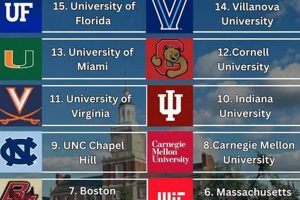Doctor of Physical Therapy (DPT) programs prepare students for careers as licensed physical therapists. High-quality programs provide rigorous coursework in areas such as kinesiology, biomechanics, and neuroscience, along with extensive clinical experience. Graduates are equipped to diagnose and treat movement dysfunction, helping patients improve mobility, manage pain, and restore function.
Choosing the right DPT program is crucial for a successful career in physical therapy. Reputable institutions offer state-of-the-art facilities, experienced faculty, and diverse clinical opportunities. This rigorous academic and practical training leads to higher competency levels, better patient outcomes, and increased career prospects for graduates. The demand for skilled physical therapists continues to grow, reflecting the aging population and increasing awareness of the benefits of physical therapy in managing various health conditions.
This article will explore various factors to consider when selecting a DPT program, including program accreditation, faculty expertise, clinical affiliations, research opportunities, and career support services. It will also delve into the current trends shaping the physical therapy profession and the future of physical therapy education.
Tips for Selecting a Doctor of Physical Therapy Program
Choosing a DPT program is a significant decision that requires careful consideration of various factors. These tips offer guidance for prospective students navigating the selection process.
Tip 1: Verify Accreditation: Ensure the program holds accreditation from the Commission on Accreditation in Physical Therapy Education (CAPTE). This signifies that the program meets rigorous quality standards and prepares graduates for licensure.
Tip 2: Evaluate Faculty Expertise: Investigate the faculty’s credentials, including their academic degrees, clinical experience, and research contributions. Experienced faculty provide valuable mentorship and contribute to a rich learning environment.
Tip 3: Assess Clinical Experiences: Explore the program’s clinical affiliations and the diversity of clinical experiences offered. Varied clinical rotations expose students to diverse patient populations and practice settings.
Tip 4: Consider Research Opportunities: If research interests you, investigate faculty research areas and opportunities for student involvement. Participating in research can enhance critical thinking skills and contribute to advancements in the field.
Tip 5: Examine Career Support Services: Inquire about career services offered to students, such as resume writing assistance, interview preparation, and job placement support. Robust career services can facilitate a smooth transition into professional practice.
Tip 6: Analyze Program Curriculum: Review the curriculum to ensure it aligns with your interests and career goals. Consider specialized tracks or elective options that cater to specific areas of physical therapy practice.
Tip 7: Visit Campuses and Attend Information Sessions: Whenever possible, visit campuses and attend information sessions to gain a firsthand understanding of the program’s culture, facilities, and resources. Interacting with current students and faculty can offer valuable insights.
By carefully considering these factors, prospective students can identify programs that align with their individual needs and aspirations, setting the stage for a successful and fulfilling career in physical therapy.
The subsequent section will discuss further resources and support systems available to prospective DPT students.
1. Accreditation
Accreditation plays a crucial role in determining the quality and legitimacy of Doctor of Physical Therapy (DPT) programs. It serves as an indicator of a program’s adherence to established educational standards and its commitment to providing students with a comprehensive and rigorous education that prepares them for professional practice. Selecting an accredited program is essential for aspiring physical therapists seeking licensure and career success.
- Regional vs. Specialized Accreditation
Regional accreditation, granted by agencies recognized by the U.S. Department of Education, covers the entire institution offering the DPT program. Specialized accreditation, specifically for DPT programs, is granted by the Commission on Accreditation in Physical Therapy Education (CAPTE). CAPTE accreditation signifies that the program meets stringent standards related to curriculum, faculty, resources, and clinical experiences. While regional accreditation is important for institutional legitimacy, CAPTE accreditation is paramount for DPT programs.
- Impact on Licensure and Employment
Graduating from a CAPTE-accredited program is typically a prerequisite for licensure in most U.S. states. Employers often prioritize candidates who have graduated from accredited programs, as it signifies a recognized level of competency and preparation. Therefore, accreditation directly impacts a graduate’s ability to obtain licensure and secure employment in the field.
- Ensuring Quality and Accountability
Accreditation ensures that programs undergo regular evaluation and maintain specific standards related to curriculum content, faculty qualifications, student support services, and clinical education experiences. This process fosters continuous improvement and accountability, contributing to the overall quality of the program and the preparation of graduates.
- CAPTE Standards and Criteria
CAPTE establishes specific standards and criteria that DPT programs must meet to achieve and maintain accreditation. These standards encompass various aspects of the program, including curriculum design, faculty expertise, clinical education, and assessment methods. These rigorous standards ensure that accredited programs provide students with a comprehensive education that aligns with current best practices in physical therapy.
In summary, accreditation, particularly CAPTE accreditation, is a critical factor to consider when evaluating DPT programs. It serves as a hallmark of quality, influences licensure and employment opportunities, and ensures that programs adhere to established standards. Prospective students are strongly encouraged to prioritize CAPTE-accredited programs when making their educational decisions to ensure they receive a high-quality education that prepares them for successful careers in physical therapy.
2. Faculty Expertise
Faculty expertise stands as a cornerstone of high-quality Doctor of Physical Therapy (DPT) programs. Distinguished faculty members contribute significantly to the educational experience, shaping future practitioners through their knowledge, mentorship, and research endeavors. A program’s faculty composition directly influences the depth and breadth of student learning, impacting both clinical proficiency and career trajectories.
- Academic Credentials and Specialization
Leading DPT programs employ faculty possessing terminal degrees (e.g., PhD, DSc) in relevant fields like kinesiology, biomechanics, or neuroscience. Specialized expertise within areas such as orthopedics, neurology, or pediatrics enriches curriculum content and allows for focused mentorship. For instance, a faculty member specializing in sports rehabilitation can provide students with in-depth knowledge and practical training in this specific area, enhancing their skillset and marketability.
- Clinical Experience and Board Certification
Extensive clinical experience among faculty members bridges the gap between theory and practice. Board certification signifies advanced competency and a commitment to professional development. Faculty actively engaged in clinical practice provide students with real-world insights, up-to-date techniques, and valuable networking opportunities. A faculty member actively practicing in a hospital setting can offer students insights into current clinical challenges and best practices.
- Research and Scholarly Activity
Faculty involvement in research advances the field of physical therapy and fosters a culture of inquiry. Active research programs provide students with opportunities to participate in cutting-edge studies, develop critical thinking skills, and contribute to new knowledge. Publications and presentations by faculty members enhance the program’s reputation and attract talented students. For example, a faculty member conducting research on innovative rehabilitation techniques can involve students in data collection and analysis, enriching their learning experience and contributing to advancements in the field.
- Mentorship and Student Support
Dedicated faculty mentors guide students throughout their DPT journey, providing individualized support and fostering professional growth. Mentors offer advice on academic progress, career choices, and research opportunities, enhancing student success and career readiness. Accessible faculty and structured mentorship programs contribute to a supportive learning environment, facilitating student development and well-being.
In summary, a program’s faculty expertise significantly influences its overall quality and its ability to produce competent and successful physical therapists. Prospective students should carefully consider the faculty’s credentials, experience, research activities, and commitment to mentorship when evaluating DPT programs. A strong faculty foundation ensures a rich educational experience and prepares graduates for fulfilling careers in a dynamic and evolving healthcare landscape.
3. Clinical Experiences
Clinical experiences form an integral component of high-quality Doctor of Physical Therapy (DPT) programs. These practical experiences bridge the gap between academic knowledge and real-world application, shaping competent and well-rounded practitioners. The nature and extent of clinical opportunities significantly influence a program’s standing and its graduates’ preparedness for professional practice.
- Diversity of Clinical Settings
Exposure to diverse clinical settings, including hospitals, outpatient clinics, rehabilitation centers, and specialized practices (e.g., pediatrics, sports medicine), is crucial for developing adaptable and well-rounded clinicians. Varied placements expose students to a broad spectrum of patient populations, conditions, and treatment approaches. A graduate with experience in multiple settings possesses a broader skillset and greater adaptability to diverse career paths.
- Mentorship from Experienced Clinicians
Effective clinical education relies heavily on mentorship from experienced clinicians. Preceptors who are actively engaged in clinical practice provide students with real-time feedback, guidance, and professional insights. Mentorship fosters the development of essential clinical skills, professional behaviors, and ethical decision-making. High-quality programs prioritize preceptors who demonstrate a commitment to student education and professional development.
- Progressive Levels of Responsibility
Structured clinical experiences often involve progressive levels of responsibility. As students gain experience and demonstrate competency, they assume greater autonomy in patient care. This gradual increase in responsibility allows for skill development, builds confidence, and prepares graduates for independent practice. Programs that offer opportunities for increased responsibility during clinical rotations contribute to graduates’ readiness for the demands of professional practice.
- Integration of Didactic and Clinical Learning
Effective DPT programs seamlessly integrate didactic coursework with clinical experiences. This integration reinforces classroom learning and allows students to apply theoretical knowledge in practical settings. Regular reflection and feedback sessions between faculty and clinical preceptors ensure that students connect classroom concepts to real-world clinical practice. This integration enhances critical thinking skills and promotes deeper understanding of physical therapy principles.
The quality and breadth of clinical experiences are paramount in distinguishing exceptional DPT programs. Robust clinical education, encompassing diverse settings, expert mentorship, progressive responsibility, and seamless integration with academic learning, produces highly skilled, adaptable, and practice-ready graduates. Prospective students should prioritize programs that offer rich and varied clinical opportunities to maximize their professional development and career prospects.
4. Curriculum Rigor
Curriculum rigor serves as a defining characteristic of top Doctor of Physical Therapy (DPT) programs. A demanding curriculum, encompassing both theoretical depth and practical application, equips graduates with the advanced knowledge and skills necessary for success in a complex and evolving healthcare landscape. This rigor manifests in several key ways, impacting both immediate learning outcomes and long-term career trajectories. For instance, a program incorporating advanced biomechanics and exercise physiology into the curriculum, beyond the basic requirements, prepares graduates for evidence-based practice and specialized roles.
A rigorous curriculum often features advanced coursework that delves deeper into specialized areas such as movement science, pathophysiology, and differential diagnosis. It emphasizes evidence-based practice, requiring students to critically evaluate research and apply findings to clinical decision-making. Furthermore, a challenging curriculum often integrates interprofessional education, exposing students to collaborative practice with other healthcare professionals, simulating real-world healthcare environments. This collaborative approach prepares graduates for integrated care models and enhances communication skills essential for effective teamwork. Advanced clinical skills training, often involving simulated patient scenarios and specialized equipment, provides opportunities to refine practical skills and develop clinical reasoning abilities. A program that incorporates these elements produces graduates prepared to handle complex cases and contribute meaningfully to patient care.
The impact of curriculum rigor extends beyond immediate educational outcomes. Graduates of programs with demanding curricula often demonstrate higher levels of clinical competency, leading to improved patient outcomes and enhanced career opportunities. Furthermore, a rigorous educational foundation prepares graduates to adapt to advancements in the field, pursue specialization, and contribute to research and innovation. Investing in a program known for its rigorous curriculum represents a commitment to professional excellence and positions graduates for leadership roles within the physical therapy profession. The long-term benefits of a demanding curriculum underscore its crucial role in shaping competent and adaptable practitioners equipped to navigate the challenges and opportunities of a dynamic healthcare landscape.
5. Career Support
Robust career support services distinguish high-quality Doctor of Physical Therapy (DPT) programs and contribute significantly to graduate success. These services play a pivotal role in connecting students with potential employers, facilitating a smooth transition from academic training to professional practice. Effective career support encompasses a range of services tailored to the specific needs of DPT students, influencing career trajectory and long-term professional growth. For example, programs that offer resume workshops, mock interviews, and networking events with local healthcare providers equip students with the tools needed to secure competitive positions. A graduate who leverages these services to secure a coveted residency position demonstrates the practical value of comprehensive career support. Similarly, guidance on navigating the licensure process, a crucial step for practicing physical therapy, ensures graduates can seamlessly enter the workforce. Programs offering dedicated licensing workshops and individualized support contribute directly to graduate success in obtaining necessary credentials.
The impact of comprehensive career support extends beyond initial job placement. High-quality programs cultivate relationships with alumni networks, creating opportunities for mentorship and professional networking. Alumni serving as mentors can provide invaluable guidance to recent graduates navigating the early stages of their careers. Furthermore, robust career services often provide continuing education resources, supporting lifelong learning and professional development. Access to continuing education opportunities allows graduates to stay abreast of advancements in the field, specialize in areas of interest, and advance their careers. This ongoing support reinforces the program’s commitment to graduate success throughout their professional journey. For example, a graduate who attends a program-sponsored continuing education workshop on advanced manual therapy techniques gains specialized skills, enhancing their marketability and career advancement potential. This continued learning, facilitated by the program’s career support services, underscores the long-term benefits of these resources.
In summary, comprehensive career support stands as a critical component of leading DPT programs. These services, encompassing job placement assistance, licensing guidance, alumni networking, and continuing education resources, significantly impact graduate success, career trajectory, and lifelong professional development. By investing in robust career support structures, programs demonstrate a commitment to preparing graduates not only for their first jobs, but for thriving careers in a dynamic and demanding healthcare field. The absence of these services can create significant challenges for graduates seeking employment and navigating the complexities of professional licensure and career advancement. Therefore, prospective students should prioritize DPT programs that offer extensive and individualized career support as a key factor in their decision-making process.
Frequently Asked Questions about Doctor of Physical Therapy Programs
This section addresses common inquiries regarding Doctor of Physical Therapy (DPT) programs, providing prospective students with essential information to navigate the application process and make informed decisions.
Question 1: How does one determine the “best” DPT program?
Program rankings should be considered alongside individual needs and preferences. Factors such as faculty expertise, clinical opportunities, research focus, and geographic location contribute to a program’s overall suitability. A program highly ranked for its research output might be less suitable for a student primarily interested in clinical practice.
Question 2: What is the typical duration of a DPT program?
Most DPT programs span three years of full-time study. This timeframe includes didactic coursework, laboratory experiences, and extensive clinical rotations.
Question 3: What are the prerequisites for applying to a DPT program?
Prerequisites vary among programs but typically include a bachelor’s degree with specific prerequisite courses in sciences such as biology, chemistry, physics, and anatomy. Many programs require applicants to take the Graduate Record Examinations (GRE). Volunteer or paid experience in a physical therapy setting is often recommended.
Question 4: What is the difference between a DPT and a Master of Physical Therapy (MPT)?
The DPT is now the entry-level degree for physical therapists in the United States. The MPT is an older degree that is no longer offered by most accredited programs.
Question 5: What career opportunities are available to DPT graduates?
Graduates can pursue careers in a variety of settings, including hospitals, outpatient clinics, rehabilitation centers, schools, home health agencies, and sports organizations. Specialization within areas like orthopedics, neurology, pediatrics, or geriatrics is also possible.
Question 6: What is the job outlook for physical therapists?
The demand for physical therapists is projected to grow significantly in the coming years, driven by an aging population and increasing recognition of the benefits of physical therapy. This positive job outlook presents promising career prospects for DPT graduates.
Choosing a DPT program represents a significant investment in one’s future. Careful consideration of individual circumstances, program characteristics, and career aspirations is essential for selecting the optimal program. Thorough research, campus visits, and conversations with current students and faculty are invaluable during this decision-making process.
Further resources and guidance on applying to DPT programs are available through professional organizations such as the American Physical Therapy Association (APTA).
Selecting the Optimal Doctor of Physical Therapy Program
Identifying institutions offering high-quality Doctor of Physical Therapy (DPT) programs requires careful evaluation of several key factors. Accreditation ensures adherence to established educational standards. Faculty expertise, encompassing academic credentials, clinical experience, and research engagement, directly impacts the quality of instruction and mentorship. The breadth and depth of clinical experiences shape practical skills and adaptability. A rigorous curriculum fosters critical thinking and prepares graduates for the complexities of contemporary practice. Robust career support services facilitate a smooth transition into the professional realm and support ongoing career development. A comprehensive understanding of these elements provides prospective students with the tools necessary to make informed decisions aligned with individual career aspirations and goals.
The selection of a DPT program represents a pivotal step towards a fulfilling career in physical therapy. Diligent research and thoughtful consideration of program characteristics empower prospective students to identify institutions best suited to their individual needs and aspirations. This investment in educational excellence positions graduates for success in a dynamic and evolving healthcare landscape, ultimately contributing to improved patient outcomes and advancements within the field of physical therapy. The future of the profession rests on the shoulders of well-prepared practitioners, emphasizing the significance of selecting the optimal educational foundation.







